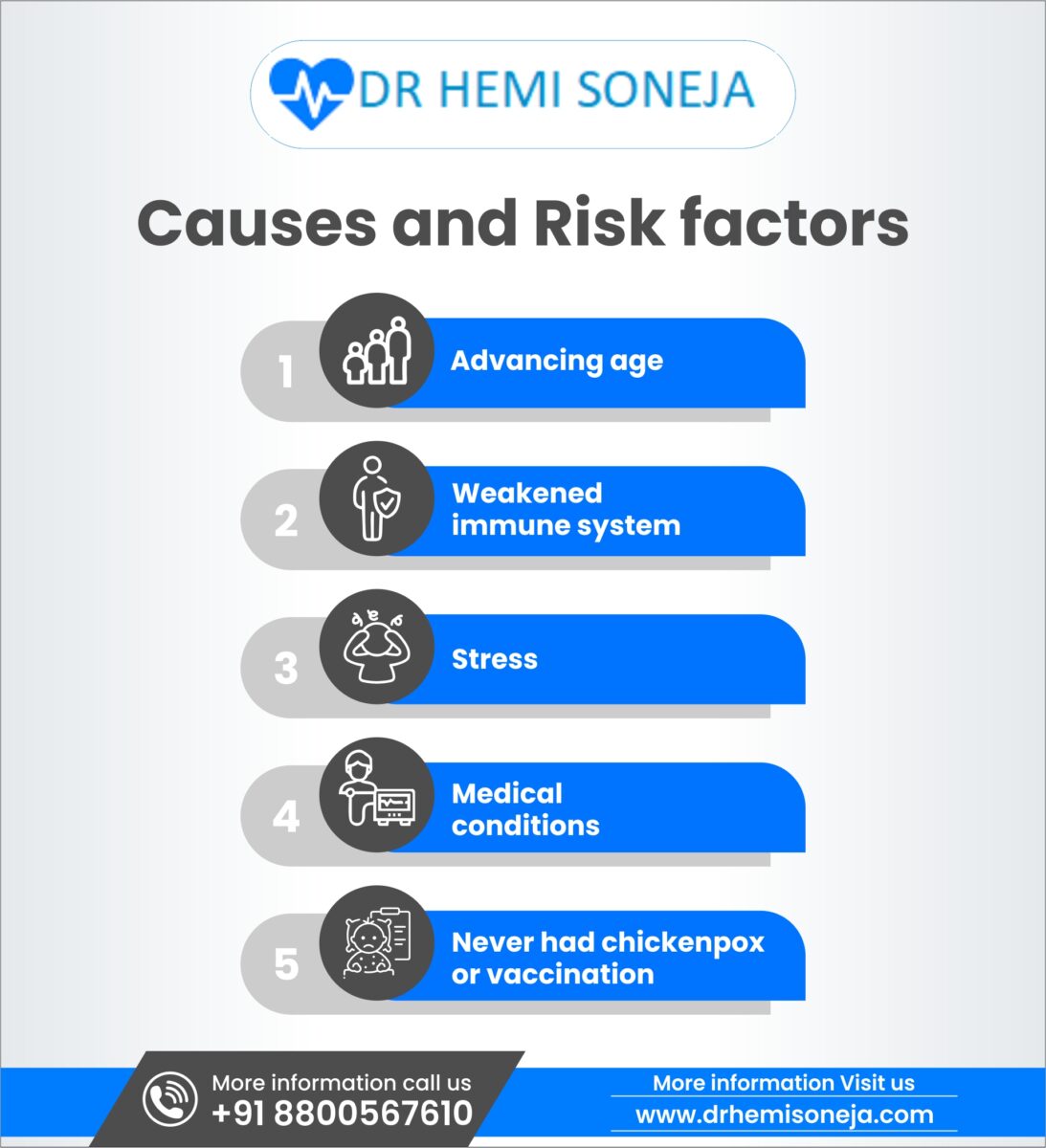Have you ever heard of shingles? It’s a condition that often flies under the radar, but its understanding is crucial for our health and well-being. Picture this: you’re enjoying life, going about your daily routine, when suddenly you’re hit with excruciating pain and a rash that appears out of nowhere. What could it be? Well, it might just be shingles. In this blog post, we’ll learn about shingles, explore their causes and symptoms, and share how you can protect yourself.
What are Shingles?
Shingles are a viral infection caused by the varicella-zoster virus. Yes, the same virus that causes chickenpox. After we recover from chickenpox, the virus doesn’t completely leave our bodies; it hides in our nerve tissues, lying dormant for years. But sometimes, for reasons not entirely understood, the virus can reactivate later in life, causing shingles.
Causes and risk factors
Several factors can trigger the reactivation of the varicella-zoster virus. It’s important to understand these risk factors to protect ourselves from shingles. Let’s take a closer look:

- Advancing age: As we grow older, our immune system weakens, making it more susceptible to infections like shingles. Adults over the age of 50 are at an increased risk.
- Weakened immune system: Certain medical conditions, such as HIV/AIDS or undergoing chemotherapy, can weaken our immune system, making it harder for the body to suppress the reactivation of the virus.
- Stress: Excessive stress can wreak havoc on our immune system, leaving us vulnerable to various illnesses, including shingles. Managing stress levels through relaxation techniques, exercise, and self-care is essential.
- Medical conditions: Certain health conditions, such as cancer, autoimmune diseases, and organ transplants, can compromise our immune system, increasing the risk of shingles.
- Never had chickenpox or vaccination: If you’ve never had chickenpox or received the varicella vaccine, you have no previous immunity to the virus. This lack of immunity puts you at a higher risk of developing shingles if you contact the varicella-zoster virus.
Knowledge of these causes and risk factors can protect us from shingles and their complications. Staying informed empowers us to make informed decisions about our health.
Symptoms and Diagnosis
Shingles usually begin with a tingling or burning sensation on one side of the body, followed by pain and the appearance of a rash. This rash typically forms into clusters of fluid-filled blisters that scab over within a week.
Identifying shingles can be challenging since the early symptoms can resemble other conditions. However, the key differentiator is the unique rash that emerges. It’s important to seek medical attention promptly if you suspect shingles to receive an accurate diagnosis and appropriate treatment.
To confirm shingles, healthcare professionals often rely on a physical examination and may perform viral tests. These tests can help differentiate shingles from other conditions with similar symptoms. Accurate diagnosis is essential to ensure proper management of the condition.
Complications and Long-Term Effects
Shingles can lead to several complications, some of which can be severe. One of the most common is postherpetic neuralgia (PHN), characterized by persistent pain in the area where the rash occurred. Additionally, shingles can cause vision loss if it affects the eyes. It can also result in bacterial skin infections.
The impact of shingles goes beyond the physical symptoms. The chronic pain associated with postherpetic neuralgia can significantly reduce a person’s quality of life, affecting their ability to perform daily activities and enjoy life fully. It’s crucial to address the emotional and psychological components of the condition in addition to its physical aspects.
Prevention
Vaccination is one of the most effective ways to protect yourself from shingles. It significantly reduces the risk and severity of shingles and can help prevent complications such as postherpetic neuralgia.
Physicians recommend that all adults over the age of 50 receive two doses of the shingles vaccine, Shingrix, separated by 2 to 6 months. Shingrix is a non-live, recombinant vaccine that provides stronger and longer-lasting protection than the previous vaccine, Zostavax.
Shingrix has been shown to be up to 90% effective in preventing shingles. It is safe and well-tolerated, with mild side effects such as soreness at the injection site, headache, and fatigue.
If you’re unsure whether you’ve received the vaccine, speak with your healthcare provider to determine your eligibility and discuss any potential concerns or risks. Remember, prevention is key, and getting vaccinated is one of the most effective ways to protect yourself from shingles.
In addition to vaccination, there are lifestyle choices you can make to strengthen your immune system and reduce the risk of shingles. Maintaining a healthy diet rich in fruits, vegetables, and whole grains, engaging in regular exercise, managing stress effectively, and getting adequate rest can all contribute to a strong immune system.
Treatment of Shingles
If you’ve been diagnosed with shingles, seeking prompt medical treatment is crucial to alleviate symptoms, promote healing, and prevent complications. Various treatment options can help manage the infection and minimize discomfort. Let’s explore the available treatment approaches in a humanized tone:
Your healthcare provider may prescribe antiviral drugs to combat the varicella-zoster virus and reduce the severity and duration of shingles. These medications work best when started within 72 hours of the rash’s appearance. They can help speed up the healing process, alleviate pain, and decrease the risk of complications.
Pain management
Shingles can cause significant pain, making it challenging to carry out daily activities. Over-the-counter pain relievers like acetaminophen or nonsteroidal anti-inflammatory drugs (NSAIDs) can help manage mild to moderate pain. These medications can provide temporary relief and improve your comfort level. If your pain is more severe, your healthcare provider may prescribe stronger pain medications or recommend topical creams or patches containing numbing agents or capsaicin.
Soothing measures
Few soothing measures at home can help to ease the itching and discomfort associated with shingles. Applying cool compresses or taking cool baths can provide temporary relief and reduce inflammation. Using calamine lotion or other gentle moisturizers can help soothe the skin and alleviate itching, promoting more comfortable healing.
Postherpetic neuralgia management
Postherpetic neuralgia (PHN) refers to persistent nerve pain that can last for months or even years after the shingles rash has healed. If you experience PHN, your healthcare provider may recommend additional treatment options. These can include prescription medications such as certain antidepressants, anticonvulsants, or topical treatments to help manage nerve pain and improve quality of life.
It’s important to consult with your healthcare provider for an accurate diagnosis and a tailored treatment plan. They will assess your symptoms, provide guidance on managing pain, and help promote healing while addressing any concerns or questions you may have.
Why choose Dr. Hemi Soneja?
Choosing Dr. Hemi Soneja as your healthcare provider brings numerous benefits. Dr. Soneja is not only highly skilled and experienced in the field of medicine but also has a compassionate and patient-centered approach. With Dr. Soneja, you can expect personalized care, clear communication, and a commitment to your well-being. Her empathetic nature and ability to understand your unique needs make them an excellent choice for addressing your health concerns. Rest assured, Dr. Soneja will go above and beyond to ensure your comfort and provide the best possible care.



